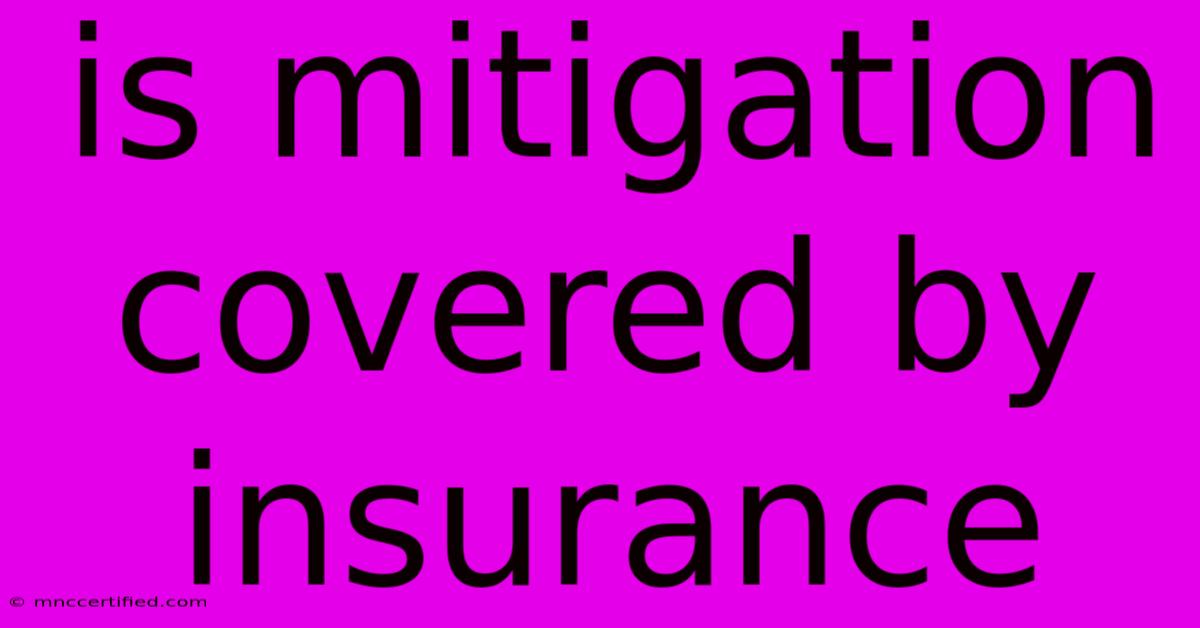Is Mitigation Covered By Insurance

Table of Contents
Is Mitigation Covered by Insurance? Understanding Your Policy's Fine Print
The short answer is: sometimes. Whether mitigation is covered by your insurance policy depends heavily on the specific type of mitigation, the cause of the damage, and the details of your insurance policy. This isn't a simple yes or no answer, so let's dive into the specifics to understand what's covered and what's not.
What is Mitigation?
Mitigation, in the context of insurance, refers to actions taken to minimize or prevent further damage after an insured event, such as a fire, flood, or windstorm. This proactive approach can significantly reduce the overall cost of repairs and recovery. Examples include:
- Emergency repairs: Boarding up broken windows after a burglary to prevent further theft or water damage.
- Water removal: Removing standing water from a flooded basement to prevent mold growth.
- Temporary repairs: Covering a damaged roof with a tarp to protect the interior from rain.
- Salvage operations: Retrieving and preserving undamaged belongings from a damaged property.
- Mold remediation: Cleaning and treating mold growth resulting from water damage.
Which Types of Insurance Cover Mitigation?
Several types of insurance policies may offer some level of mitigation coverage, but the extent varies greatly. These include:
- Homeowners Insurance: Often covers mitigation expenses related to covered perils (e.g., fire, wind, hail). However, policies usually specify a limit on these expenses. Carefully review your policy's definition of "covered perils" and "additional coverages."
- Renters Insurance: Similar to homeowners insurance, it can cover mitigation expenses for covered events, but the coverage is generally less extensive.
- Flood Insurance (NFIP): The National Flood Insurance Program explicitly covers some mitigation measures, particularly those designed to reduce future flood risk.
- Commercial Property Insurance: Covers mitigation related to damage to business property resulting from covered perils. The extent of coverage depends on the specific policy.
What is Usually NOT Covered by Mitigation?
While many mitigation efforts are covered, some typically are not. These include:
- Preventive measures: Actions taken before an insured event occur are generally not covered. For example, preemptively installing flood barriers before a flood isn't usually reimbursed.
- Negligence: Mitigation efforts resulting from the policyholder's negligence are unlikely to be covered. For instance, failing to address a minor leak that leads to major water damage.
- Exclusions: Your policy will explicitly list exclusions – events or circumstances it will not cover. Thoroughly review these exclusions.
- Costs exceeding policy limits: Even if the mitigation is covered, the insurance company may only pay up to a specific limit.
How to Ensure Your Mitigation is Covered
To maximize the chances of your mitigation efforts being covered:
- Report the loss immediately: Promptly notifying your insurance company is crucial.
- Document everything: Keep detailed records of all mitigation expenses, including receipts, invoices, and photos.
- Follow your insurer's instructions: Your insurer might require you to obtain their approval before undertaking certain mitigation activities. Disregarding their instructions could jeopardize your claim.
- Use licensed professionals: Hiring qualified professionals for significant mitigation tasks provides credible evidence of necessary and reasonable expenses.
- Read your policy carefully: This is the most important step! Understanding your policy's coverage limits, exclusions, and definitions is critical.
Key Takeaways: Mitigation and Your Insurance Policy
Mitigation is crucial for minimizing damage after an insured event. However, its coverage is not guaranteed. Always read your policy carefully, understand your coverage limits, and keep detailed records of all mitigation expenses. If you have questions or uncertainties, contact your insurance provider directly for clarification. Proactive planning and a thorough understanding of your insurance policy are essential for navigating the complexities of mitigation coverage.

Thank you for visiting our website wich cover about Is Mitigation Covered By Insurance. We hope the information provided has been useful to you. Feel free to contact us if you have any questions or need further assistance. See you next time and dont miss to bookmark.
Featured Posts
-
Robert Miller Florida Investment
Nov 17, 2024
-
Is Mitigation Covered By Insurance
Nov 17, 2024
-
Foxs 60 Points Kings Franchise Record
Nov 17, 2024
-
Celebrating Jon Kennys Father Ted Legacy
Nov 17, 2024
-
Shelter Insurance Bowling Green Mo
Nov 17, 2024